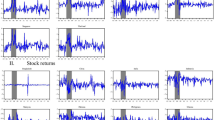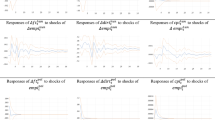Abstract
This paper investigates whether, during the Asian crisis, contagion occurred from Thailand to the other crisis countries through the foreign exchange market, and, if so, determines the contribution of this contagion to the crisis. More specifically, we examine whether the effect of the exchange market pressure (EMP) of Thailand, the origin of the crisis, on the EMP of four Asian crisis countries increased during the crisis. Instead of measuring contagion by the commonly used correlation coefficients, we apply regression analysis. To control for the impact of macroeconomic fundamentals, we construct a time-varying indicator measuring the fragility of each economy. Additionally, we control for spillovers and common external shocks. We find evidence of contagion from Thailand to Indonesia and Malaysia, with 13 and 21 percent of the pressure on the respective currencies attributable to that contagion. For Korea and the Philippines there is no evidence of contagion from Thailand.
Similar content being viewed by others
References
Baig, T., and I. Goldfajn (1999). Financial Market Contagion in the Asian Crisis. IMF Staff Papers 46 (2): 167–195.
Boyer, B., M. Gibson, and M. Loretan (1999). Pitfalls in Tests for Changes in Correlation. Federal Reserve Board International Finance Discussion Paper 597.
Calvo, S., and C. Reinhart (1996). Capital Flows in Latin America: Is There Evidence of Contagion Effects? In G. Calvo, M. Goldstein, and E. Hochreiter (eds.), Private Capital Flows to Emerging Markets after the Mexican Crisis. Washington, D.C.: Institute for International Economics.
Chou, R., V. Ng, and L. Pi (1994). Cointegration of International Stock Market Indices. IMF Working Paper 94/94. International Monetary Fund, Washington, D.C.
Claessens, S., R. Dornbusch, and Y. Park (2001). Contagion: Why Crises Spread and How This Can Be Stopped. In S. Claessens and K. Forbes (eds.), International Financial Contagion. Boston: Kluwer Academic.
Corsetti, G., M. Pericoli, and M. Sbarcia (2002). Some Contagion, Some Interdependence: More Pitfalls in Tests of Financial Contagion. CEPR Discussion Paper 3310. Center for Economic Policy and Research, Washington, D.C.
De Gregorio, J., and R. Valdes (2001). Crisis Transmission: Evidence from the Debt, Tequila and Asian Flu Crises. In S. Claessens and K. Forbes (eds.), International Financial Contagion. Boston: Kluwer Academic.
Dungey, M., and V. Martin (2004). A Multifactor Model of Exchange Rates with Unanticipated Shocks: Measuring Contagion in the East Asian Currency Market. Journal of Emerging Markets Finance 3 (3): 305–330.
Edwards, S. (2000). Interest Rates, Contagion and Capital Controls. NBER Working Paper 7801. National Bureau of Economic Research, Cambridge, Mass.
Eichengreen, B., A. Rose, and C. Wyplosz (1996). Contagious Currency Crises. NBER Working Paper 5681. National Bureau of Economic Research, Cambridge, Mass.
Forbes, K., and R. Rigobón (2001). Measuring Contagion: Conceptual and Empirical Issues. In S. Claessens and K. Forbes (eds.), International Financial Contagion. Boston: Kluwer Academic.
Forbes, K., and R. Rigobón (2002). No Contagion, Only Interdependence: Measuring Stock Market Co-Movements. Journal of Finance 57 (5): 2223–2261.
Frankel, J., and S. Schmukler (1998). Crisis, Contagion, and Country Funds. In R. Glick (ed.), Managing Capital Flows and Exchange Rates. Cambridge: Cambridge University Press.
Ganapolsky, E., and S. Schmukler (2001). Crisis Management in Argentina during the 1994–95 Mexican Crisis: How Did Markets React? World Bank Economists’ Forum 1: 3–30.
Gelos, R. G., and R. Sahay (2001). Financial Spillovers in Transition Economies. Economics of Transition 9 (1): 53–86.
Girton, L., and D. Roper (1977). A Monetary Model of Exchange Market Pressure Applied to the Post-War Canadian Experience. American Economic Review 67 (4): 537–548.
Glick, R., and A. Rose (1999). Contagion and Trade: Why Are Currency Crises Regional? Journal of International Money and Finance 18 (4): 603–617.
Greene, W. (2003). Econometric Analysis. Upper Saddle River: Prentice-Hall.
Hamao, Y., R. Masulis, and V. Ng (1990). Correlations in Price Changes and Volatility across International Stock Markets. Review of Financial Studies 3 (2): 281–307.
Kaminsky, G. (1999). Currency and Banking Crises: The Early Warnings of Distress. IMF Working Paper 99/178. International Monetary Fund, Washington, D.C.
Kaminsky, G., and C. Reinhart (1999). The Twin Crises: The Causes of Banking and Balance-of-Payments Problems. American Economic Review 89 (3): 473–500.
Kaminsky, G., and C. Reinhart (2000). On Crises, Contagion, and Confusion. Journal of International Economics 51 (1): 145–168.
Kaminsky, G., and S. Schmukler (2002). What Triggers Market Jitters? A Chronicle of the East Asian Crisis. Journal of International Money and Finance 18 (4): 537–560.
King, M., and S. Wadhwani (1990). Transmission of Volatility between Stock Markets. Review of Financial Studies 3 (1): 5–33.
Kleimeier, S., T. Lehnert, and W. Verschoor (2003). Contagion versus Interdependence: A Re-Examination of Asian-Crisis Stock Market Comovements. Mimeo. Limburg Institute of Financial Economics.
Loretan, M., and W. English (2000). Evaluating “Correlation Breakdowns” during Periods of Market Volatility. In International Financial Markets and the Implication for Monetary and Financial Stability. Basel: Bank for International Settlements.
Pagan, A. (1984). Econometric Issues in the Analysis of Regressions with Generated Regressors. International Economic Review 25 (1): 221–247.
Park, Y., and C. Song (2001). Financial Contagion in the East Asian Crisis—With Special Reference to the Republic of Korea. In S. Claessens and K. Forbes (eds.), International Financial Contagion. Boston: Kluwer Academic.
Pericoli, M., and M. Sbracia (2003). A Primer on Financial Contagion. Journal of Economic Surveys 17 (4): 571–608.
Valdes, R. (1997). Emerging Markets Contagion: Evidence and Theory. Working Paper 07. Bank of Chile, Santiago.
Author information
Authors and Affiliations
Corresponding author
Additional information
JEL no.
F30, F31, G15
About this article
Cite this article
van Horen, N., Jager, H. & Klaassen, F. Foreign Exchange Market Contagion in the Asian Crisis: A Regression-Based Approach. Rev. World Econ. 142, 374–401 (2006). https://doi.org/10.1007/s10290-006-0072-x
Issue Date:
DOI: https://doi.org/10.1007/s10290-006-0072-x




